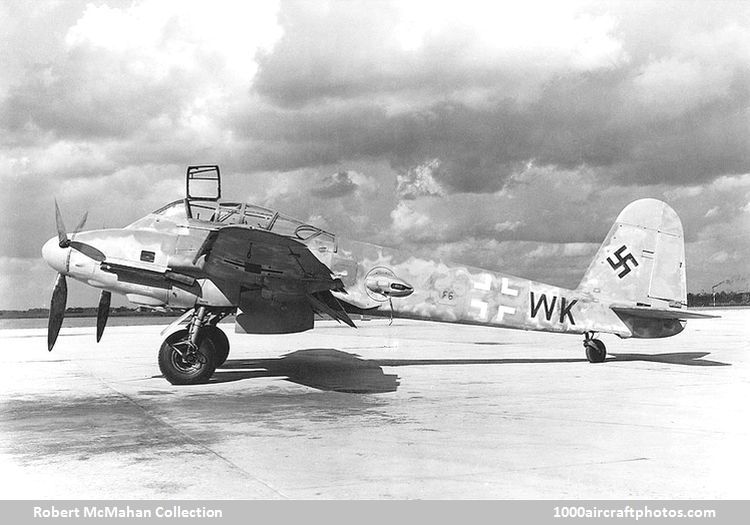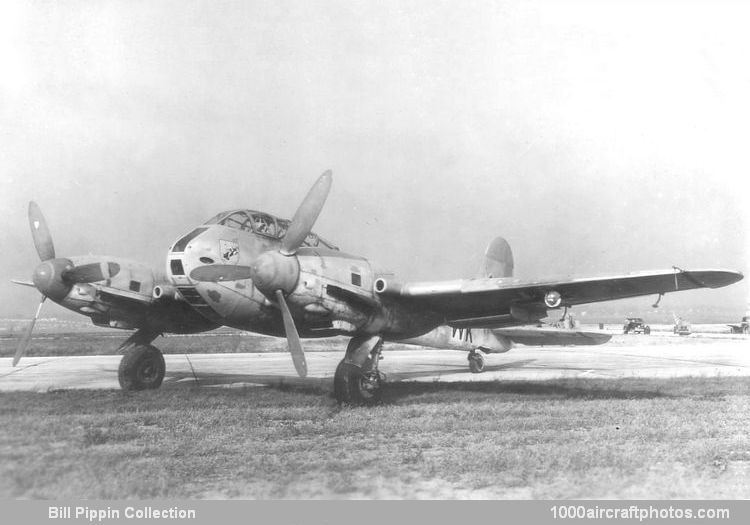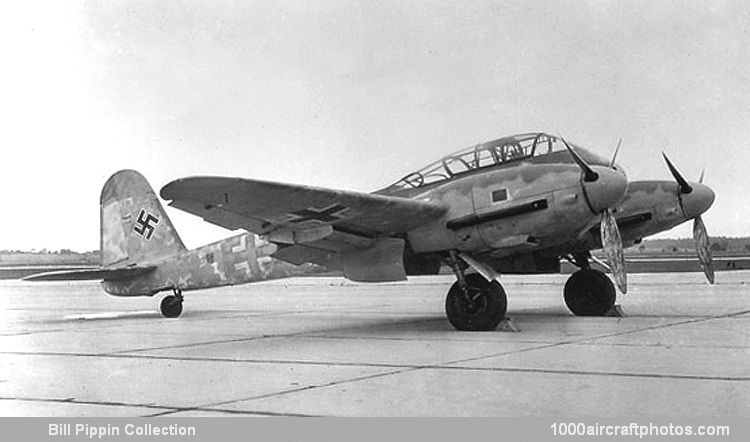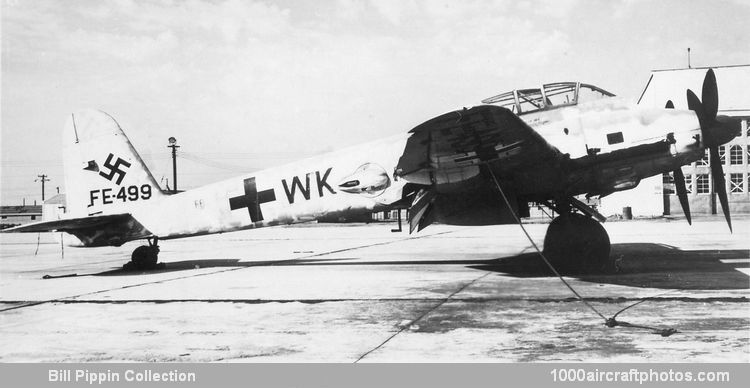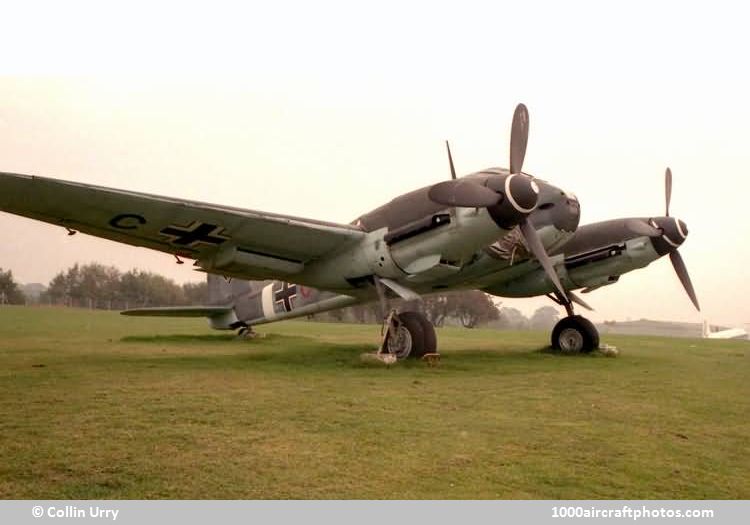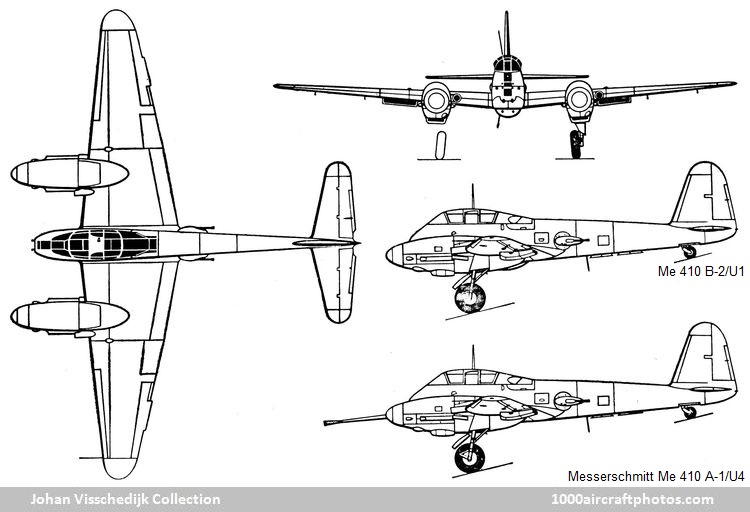11/30/2016. Remarks by Johan Visschedijk: "With the failure of the Me 210, the Messerschmitt design team proposed the Me 310 with a pressurized cabin and two 1,750 hp Daimler/Benz DB 603A twelve-cylinder liquid-cooled inverted V-engines. The armament of the Me 310 was to have remained the same as that of the Me 210 A-1 and various improvements were to have been incorporated, including an increase in overall wing span. In order to simplify production, however, the RLM showed a preference for a less radically altered development of the Me 210 which was designated Me 410 and named Hornisse (Hornet).
Apart from the installation of DB 603A engines, which increased overall length by some 8 in (20 cm) over that of the modified Me 210A, the Hornisse was essentially similar to the earlier machine with all its progressive modifications, such as leading edge slots. The first true prototype of the Hornisse, the Me 410 V1, was completed after a batch of six Me 210 As had been modified to Me 410 standards for service testing, and towards the end of 1942 the RLM ordered quantity production to be initiated, 291 machines being delivered in 1943, and 722 being produced in 1944 when further manufacture of the type was abandoned. Production of the Me 410 was also undertaken in Hungary by the Donau Flugzeugbau for the Luftwaffe, this concern's plant south of Budapest producing 34 machines in 1943, and a further 74 by July 1944 when the plant was knocked out by Allied air attacks. The following versions were produced.
Me 410 A-1. This was the initial production model of the Hornisse, a light bomber with a fixed forward-firing armament of two 0.311 in (7.9 mm) MG 17 and two 0.787 in (20 mm) MG 151 guns plus two 0.511 in (13 mm) MG 131 guns firing aft from remotely-controlled rotatable barbettes. The maximum internal bomb load was two 2,205 lb (1,000 kg) SD 1000 bombs, but a more usual load was eight 110 lb (50 kg) SC 50 bombs internally and four similar bombs externally on racks beneath the wing roots.
Me 410 A-1/U1. This was a photo reconnaissance modification with the two forward-firing MG 17 machine guns deleted and an RB 20/30, 50/30 or 75/30 camera in the bomb-bay.
Me 410 A-1/U2. A fighter conversion in which the built-in armament was supplanted by a WB 151A (Waffen-Behälter 151A), a drum-like container housing twin 0.787 in (20 mm) MG 151 guns and their ammunition, and installed in the bomb-bay.
Me 410 A-1/U4. Bomber destroyer carrying a 1.97 in (50 mm) BK 5 cannon – an old armored car gun adapted for aircraft use – all other forward-firing armament being deleted.
Me 410 A-2. A destroyer with a fixed forward-firing armament of two 0.787 in (20 mm) MG 151 guns and two 1.18 in (30 mm) MK 103 cannon, and two 0.511 in (13 mm) MG 131 guns in the aft remotely-controlled rotatable barbettes.
Me 410 A-2/U2. Night fighter conversion.
Me 410 A-2/U4. Bomber destroyer similar to the Me 410 A-1/U4.
Me 410 A-3. Photo-reconnaissance aircraft which carried three cameras in a swollen bomb-bay.
Me 410 B-1. Differing from the A-1 principally in having the forward-firing 0.311 in (7.9 mm) MG 17 machine guns replaced by 0.511 in (13 mm) MG 131s, and being intended for the light bomber role.
Me 410 B-2. Destroyer with a WB 151A container in its bomb-bay, and the B-2/R2 and B-2/R3 respectively carried a pair of 1.18 in (30 mm) MK 108 and MK 103 cannon supplementing the normal forward-firing armament.
Me 410 B-2/U1. Standard built-in armament plus a WB 151A installation and a WT 151A (Waffen-Tropfen 151A) installation which was a bulged fairing mounted externally at the aft end of the bomb-bay and containing two 0.787 in (20 mm) MG 151 cannon and their ammunition. Forward-firing armament of this variant thus became six MG 151 cannon and two MG 131 machine guns.
Me 410 B-2/U2. Carried four 0.787 in (20 mm) MG 151 cannon in the bomb-bay.
Me 410 B-2/U3. Anti-shipping aircraft with the two forward-firing MG 131s deleted to make room for an FuG 200 Hohentwiel search radar array, two 1.18 in (30 mm) MK 103 cannon mounted in the bomb-bay, and provision for a single torpedo under the fuselage.
Me 410 B-3. Reconnaissance-fighter, which carried the standard gun armament and three cameras in a swollen bomb-bay.
The Hornisse pictured at the top of the page was originally an Me 410 A-2 destroyer built by Messerschmitt at Augsburg, Germany and initially coded "SI+KZ". Later it was fitted with an Umrüstsätz (conversion kit) and converted to a Me 410 A-2/U1 photo-reconnaissance aircraft.
